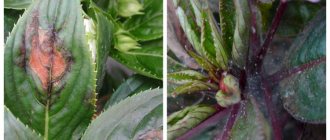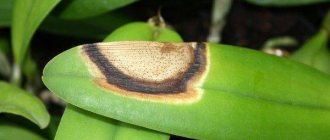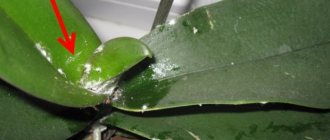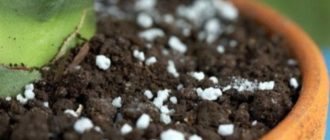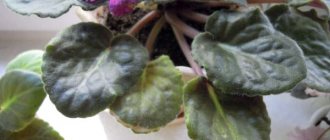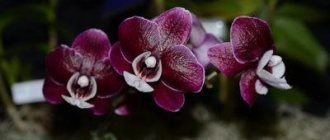Fusarium plant blight is a dangerous disease. Its existence became known during the Second World War. Significant damage was caused to the agricultural industry. It turned out that after an infection, the fruits of the plants become inedible. It took many years to find the cause and treatments. Indoor orchids phalaenopsis and calantha, cylagina and paphiopedilum, brassia and cattleya, cymbidium and oncidium, any varieties, ordinary and exhibition specimens can get it. Two types of fungi from the Fusarium family are dangerous - Fusarium solani and Fusarium oxysporum.
Pathogens of fusarium
The cause of the disease on the orchid is moldy fungi from the genus Fusarium. Experts who studied the problem of the appearance, symptoms and spread of pathogens on orchid plants agreed that the root system, as a rule, is parasitized by the fungus Fusarium oxysporum, causing it to rot.
Another fungus was noticed on the aerial part - Fusarium moniliforme, and it mainly provokes first fusarium wilting of the leaves, stems, flowers and tuberidia of the orchid, and then rotting.
What is the danger?
Fusarium fungi lead to blockage of the main vessels of the orchid (in the root, on the leaves and in the stem). The result is dehydration and wilting. The green parts darken and dents appear on them. If the infection has affected only the above-ground part of the plant, therapeutic measures can be taken. If the rot has spread to the root, the orchid will die.
A diseased plant poses a danger to neighboring flowers, since the fungal spores of Fusarium are very contagious.
How to recognize fusarium on phalaenopsis and other orchids
Fusarium fungi spread through colorful conidia that are pink-crimson, purple, violet or white. If dust or small balls of the indicated color are noticed on the plant, then there is practically no doubt - the orchid is infected with Fusarium oxysporum. The fungus clogs the vessels of the tissues of the root or leaf blade, resulting in a dark depressed area.
It is initially difficult to diagnose fusarium on the root system of phalaenopsis, since the affected areas resemble a tan from bright sunlight. A lot of time passes - from 8 to 18 months - before depressed areas appear on the roots, as if pulled by a thread.
The “tanned” spots darken over time and become covered with multi-colored spores, and only at this stage does it become clear that the plant is infected with the fungus Fusarium oxysporum. At this time, the rot of the root system is already progressing with might and main, and the foliage, especially the old ones, instantly turns yellow and dies. The plant withers and has no chance of survival.
The onset of the disease does not necessarily occur from the root system. Often conidia appear in the core or on the stem. The affected areas turn yellow and red or simply look depressed and very soon acquire a brownish tint and rot. As a rule, this is how Fusarium moniliforme manifests itself, which is usually found on flowers, peduncles and foliage.
On Cattleyas, Dendrobiums, Laelias and Oncidiums, the symptoms of damage to the root system are similar to those of Phalaenopsis root disease, but at later stages, when the lesion creeps up the plant, purple or burgundy stains are clearly visible at the base of the tuberidia and on the rhizome. The infection of Paphiopedilum is also in many ways reminiscent of the appearance of a fungus on the roots of phalaenopsis, but it is concentrated at the neck of the root, developing wet rot at the base of the rosette, and the leaves are easily pulled out.
How to fight with folk remedies?
At home, chemicals can be replaced with products prepared according to folk recipes. The most common of them:
- Ash infusion - 1 kg of ash is dissolved in 10 liters of water at a temperature of +30 ° C and left for 5 days. Then the liquid is filtered and diluted with liquid laundry soap. The resulting drug is used to treat fungal diseases. The plant is treated 3 times with an interval of 1 day.
- Whey - the product is diluted with water in a ratio of 1:10. Spraying is performed to prevent fungal infections once every 14 days.
- Infusion of horsetail (100 g / 1 l of water) - the drug is used to treat powdery mildew.
- Potassium permanganate solution (2 g/10 l of water) – treatment is recommended in an amount of 3 times.
Favorable conditions for the development of fusarium rot
An environment conducive to the emergence and development of fusarium rot pathogens is formed as a result of the presence of certain factors:
- an excess of salts in the substrate occurs not only as a result of violation of the doses of fertilizer or fertilizing regime, but also as a result of watering with tap water. Experienced orchid growers recommend replanting orchids at least every 2–3 years, but also rinsing the substrate with distilled water every 6–8 months;
- a high proportion of peat or polystyrene foam in the substrate, which lowers the overall pH and acidifies it to such an extent that beneficial microorganisms die, preventing the proliferation of fungi. The proportion of these components in the substrate should not exceed 10–20%;
- lack of drying of the soil mixture due to improperly organized irrigation regime;
- low temperature of the substrate inside the flower container, and this may not necessarily be obvious hypothermia, but also active evaporation after watering, as a result of which the roots become supercooled.
Reasons for appearance
Mechanical damage
It would seem that the leaf was slightly touched when watering... Or the cat ran along the windowsill... Nothing terrible happened. Perhaps it happened. Orchids are very susceptible to mechanical damage. A pathogen may enter the scratch site.
Tip: broken plants can be treated with activated carbon or cinnamon (crushed and applied to the damaged area).
Pests
Fusarium is transmitted by sucking insects. Therefore, it is important to carefully monitor their presence in the house as a preventive measure for fusarium. As necessary, destroy and treat the orchid roots with a fungicide.
Stomata on leaves
Stomata are pores that form on the surface of leaves for air exchange and photosynthesis. These pores are an excellent conductor for a variety of infections, including fusarium.
Attention: it is impossible to completely protect a plant from infectious diseases. However, it is quite possible to observe quarantine measures to keep diseased plants separate from healthy ones.
In order for a disease to occur, one or more circumstances must exist:
- Lack of light leads to soil not drying out and causes rotting processes.
- A room microclimate that is too cold or hot will lead to either freezing or evaporation of moisture and drought.
- Excessively peaty soil interferes with the proliferation of beneficial microorganisms.
Treatment of fusarium rot on an orchid
An orchid grower who discovers symptoms similar to fusarium on his plants must immediately isolate the affected plants separately from healthy ones in another room, since the infection spreads very quickly to healthy orchids.
Next, you will have to decide what to do with the diseased orchid. It should be recalled that only a laboratory test will give one hundred percent confidence in the cause of the disease; it can easily be mistaken for fusarium and another problem, the same sunburn on the root system. That’s why you shouldn’t immediately cut off the reddened roots, but only take up the scissors when suspicious areas begin to change color or press in.
If, however, there is still no doubt about the culprit for the appearance of pink or white spore spots, you can try to save the flower even with a completely rotten root system, but with an intact above-ground part. To do this, all lifeless roots are removed, and the entire orchid is treated with a fungicide solution. It is selected based on the manufacturer’s instructions for use for certain diseases, including fusarium. Based on the opinions of experienced orchid growers who are dealing with saving their collection of home orchids from fusarium rot, in most cases foundationazole or benomyl helps.
It is necessary to remind flower growers that many methods of resuscitating indoor plants in the case of fusarium are not suitable, for example, greenhouses or soaking in water. After treatment, the plant is placed in a well-lit and moderately warm place, sprayed regularly, once a week.
The orchid must be in quarantine for at least 20 days. Only after this time, if there are no new signs of the spread of fungus on the plant, can you begin manipulations to restore the root system using any of the known methods of resuscitating orchids.
However, it is worth warning orchid growers that after quarantine they must be prepared for the fact that the plant will no longer help or need anything.
Disease prevention
A well-groomed plant, which has enough nutrients, sunlight, and warmth, will show a greater degree of endurance and will more easily accept treatment. Prevention will save you from worry. Flower growers and orchid fans need to focus on this. Moreover, there are effective preventive methods that provide a 100% guarantee.
On a rainy day
Fusarium spores are most active in cold weather, after rains. If it suddenly gets colder in the summer, the sun is hidden behind thunderclouds, it is advisable to turn on the air conditioning, close the vents and windows. Fusarium mushrooms are a common microorganism in nature. They can live in any country, in any region.
Window sill cleaning
It is useful to turn on ultraviolet lamps from time to time and disinfect the room with them. Such treatment is important for the prevention of fusarium and eliminating the consequences. Spores can fly to neighboring flowers or end up on a windowsill, wallpaper, books, or trash can. This happens more often when the fungal population begins to dominate. But even in the early stages such a turn of events is likely. The use of ultraviolet lamps, cleaning products, and a steam cleaner when cleaning on the windowsill reduces the risk of primary or secondary infection.
Treating the soil with copper sulfate during replanting
In agricultural practice, copper sulfate is used as a fertilizer and prophylactic agent to eliminate fusarium. It will also come in handy when preparing the soil for flower transplantation.
Orchids need copper; it is an important part of its nutrition.
Copper sulfate is one of its sources. It should be used with caution, keeping in mind microfungi. They transform the copper that is already contained in the soil in a form inaccessible to the plant into an easily digestible form.
Fungicide can harm them. The soil should be treated with the solution several days before replanting the flower or germinating the seeds. There will no longer be any disputes left in it and an unfavorable environment for their development will be formed.
Viruses
The defeat of domestic orchids by a real virus is something out of the ordinary. Because in the industrial cultivation of plants this issue is approached very harshly. All infected copies are destroyed.
Symptoms. Chlorotic and necrotic spots, stripes, lines or rings on leaves, rarely flowers, slow growth, poor, irregular flowering.
Taiwan Orchid Virus
It is very difficult to accurately diagnose the virus based on visual symptoms alone, as it can masquerade as other diseases. The pathogen can only be identified in laboratory conditions.
Most often, it happens that symptoms suspected of a virus are actually symptoms of banal waterlogging.
But just in case, remember that viruses are incurable, but plants do not die from them. When the conditions are normalized, the symptoms disappear and an orchid with strong immunity can continue to live with this virus for a long time.
Brown (bacterial) rot
Phalaenopsis, cattleya, cymbidium and paphiopedilum are most susceptible to this disease.
If light brown and watery spots appear on the shoots and young leaves of the orchid, the plant most likely has brown rot. Over time, the spots may begin to darken, increase in size and merge with each other. Most often, this disease affects young leaves.
The damage process is especially accelerated by abundant watering and low air temperature in the place where the orchid is kept.
If the damage is minimal, the orchid can still be helped. To do this, using a sharp instrument, you need to cut out the affected areas to healthy tissue. Next, the cut areas should be sprinkled with crushed coal and treated with a copper-containing preparation, for example, Bordeaux mixture. After the “surgery,” the orchid should be kept in the conditions indicated for the specific species.
If the damage is too severe, then it is almost impossible to cure an orchid that has become infected with brown rot. No matter how pitiful the plant is, it is best to destroy it before the diseased flower infects the healthy ones.
To prevent brown rot, you can spray the orchid with copper sulfate once a month.

